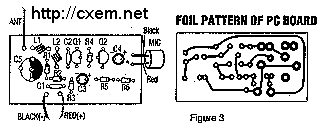FM Transmitter
Here is the schematic, PC board pattern, and parts placement for a low powered FM transmitter. The range of the transmitter when running at 9V is about 300 feet. Running it from 12V increases the range to about 400 feet. This transmitter should not be used as a room or telephone bug.
Schematic

PC board layout and parts placement

Parts:
|
|
|
|
|
| C1 | 1 | 0.001uf Disc Capacitor | |
| C2 | 1 | 5.6pf Disc Capacitor | |
| C3,C4 | 2 | 10uf Electrolytic Capacitor | |
| C5 | 1 | 3-18pf Adjustable Cap | |
| R1 | 1 | 270 Ohm 1/8W Resistor | 270 Ohm 1/4W Resistor |
| R2,R5,R6 | 3 | 4.7k 1/8W Resistor | 4.7K 1/4W Resistor |
| R3 | 1 | 10k 1/8W Resistor | 10K 1/4W Resistor |
| R4 | 1 | 100k 1/8W Resistor | 100K 1/4W Resistor |
| Q1, Q2 | 2 | 2N2222A NPN Transistor | 2N3904 |
| L1, L2 | 2 | 5 Turn Air Core Coil | |
| MIC | 1 | Electret Microphone | |
| MISC | 1 | 9V Battery Snap, PC Board, Wire For Antenna |
Description:
While there are a plethora of similar 2-transistor schematics available, this one is above average. A major improvement over the little 1-transistor circuit that we've discussed previously, this transmitter consist of two stages. The first transistor is used to amplify audio, which means that the microphone is now much more sensitive to sound. The second one acts as an oscillator.
All in all, this is an interesting project for beginners and more experienced hobbyists alike. Use any stiff wire or telescope whip antenna, just make sure that it's not too long. Range should be about 100m or even more in the open. Stability is still a problem, though.
Problems:
The coils should be identical to ensure proper operation. Do not speak to closely to the microphone. It's so sensitive that you can easily overdrive the circuit.
Notes:
1. L1 and L2 are 5 turns of 28 AWG enamel coated magnet wire wound with a inside diameter of about 4mm. The inside of a ballpoint pen works well (the plastic tube that holds the ink). Remove the form after winding then install the coil on the circuit board, being careful not to bend it.
2. C5 is used for tuning. This transmitter operates on the normal broadcast frequencies (88-108MHz).
3. Q1 and Q2 can also be 2N3904 or something similar.
4. You can use 1/4 W resistors mounted vertically instead of 1/8 W resistors.
5. You may want to bypass the battery with a .01uf capacitor.
6. An antenna may not be required for operation.






